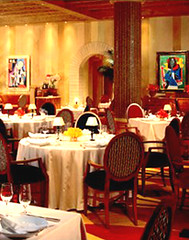On one hand, CBS is doing everything right with Jericho (although seeing a corporation encourage what started as a hip fan-based “Jericho Digg-a-thon” is a bit out of the ordinary). On the other hand, CBS went with an exhibition game featuring the Bills vs. Saints last night.
While there is nothing wrong with that (football is big bucks, even in preseason), it rightfully raised the dander of some fans. The reason? Miscommunication or a lack of communication all together.
When you have several thousand fans promoting a show at a set time every Friday night, they feel kind of silly when their friends call them, e-mail them, or twit them back to ask “What show?” It’s not the first time this week someone noted CBS seems to have two messages…
“We want them to watch at 8 o'clock," Nina Tassler, president of CBS Entertainment, told The New York Times. “And we need them to recruit viewers who are going to watch the broadcast."
“So at the end of the day, as long as I'm getting paid for it, I don't care whether you are watching CSI on CBS at 9 p.m. on Thursday night, on your DVR, if you are getting it on Amazon.com, or CBS.com,” said Les Moonves, CEO of CBS, Inc. to The New Yorker's Ken Auletta three days later. “So once again, the distinction, you are still watching CSI.”
Wow. If that’s true, then Jericho fans have a lot more leverage than I imagined. If that’s true, then Jericho fans are almost certain to have a third season. If that’s true, then “if” seems to be the operative word when it comes to Jericho.
Sometimes people seem unsure about my suggestion to develop consistent messages from a core message system that resonates throughout a company and then outward through various audiences, regardless of the company’s size. But the quotes above provide the reason. CBS cannot be dependent on the Nielsen ratings and free from it at the same time. Can they? And here I thought quantum physics was more likely to be found in Eureka.
There are six days left to enter Copywrite, Ink.'s contribution to consumer-generated Jericho buzz:. The free “Expanded Universe Short Story Competition” entry deadline is Aug. 17.

While there is nothing wrong with that (football is big bucks, even in preseason), it rightfully raised the dander of some fans. The reason? Miscommunication or a lack of communication all together.
When you have several thousand fans promoting a show at a set time every Friday night, they feel kind of silly when their friends call them, e-mail them, or twit them back to ask “What show?” It’s not the first time this week someone noted CBS seems to have two messages…
“We want them to watch at 8 o'clock," Nina Tassler, president of CBS Entertainment, told The New York Times. “And we need them to recruit viewers who are going to watch the broadcast."
“So at the end of the day, as long as I'm getting paid for it, I don't care whether you are watching CSI on CBS at 9 p.m. on Thursday night, on your DVR, if you are getting it on Amazon.com, or CBS.com,” said Les Moonves, CEO of CBS, Inc. to The New Yorker's Ken Auletta three days later. “So once again, the distinction, you are still watching CSI.”
Wow. If that’s true, then Jericho fans have a lot more leverage than I imagined. If that’s true, then Jericho fans are almost certain to have a third season. If that’s true, then “if” seems to be the operative word when it comes to Jericho.
Sometimes people seem unsure about my suggestion to develop consistent messages from a core message system that resonates throughout a company and then outward through various audiences, regardless of the company’s size. But the quotes above provide the reason. CBS cannot be dependent on the Nielsen ratings and free from it at the same time. Can they? And here I thought quantum physics was more likely to be found in Eureka.
There are six days left to enter Copywrite, Ink.'s contribution to consumer-generated Jericho buzz:. The free “Expanded Universe Short Story Competition” entry deadline is Aug. 17.




















